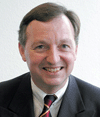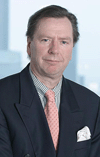Stunted growth?

‘We do not believe that trust in the fund product as such or in the fund industry has declined. The only thing that has suffered since the downturn of equity markets is trust in the potential of capital markets, in particular of equities’ - Wolfgang Mansfeld, Efama
Woeful inflows into European money market funds in 2004 obscure the fact that interest in guaranteed and cross-border funds grew appreciably. Paula Garrido explains why the pace of growth can be considered less important than the evolutionary development of the European fund management industry as a whole
Opinions vary greatly as to what kind of a year the European fund management industry actually had in 2004. First a report from FERI Fund Market Information released in February described 2004 as an annus horribilis for European fund groups with net sales of funds down 39 per cent compared with 2003. According to FERI, only three markets – Austria, Finland and Norway – managed to improve on their 2003 net sales records. Their report reads: “The haemorrhage out of money market funds in 2004 was spectacular”, with the sector loosing ?29m during that period.
This negative picture of the industry has since been challenged by figures from the European Fund and Asset Management Association (Efama), formerly Fefsi, which last month announced that 2004 “was a good year overall”.
“[FERI] based its data on the analysis of total inflows, and I think we should distinguish between long-term and money market funds,” said Efama’s president Wolfgang Mansfeld at an industry summit in Brussels. “If we concentrate on long-term investments, that excludes money market funds, where we see that have had a clear increase in 2004 compared with 2003. Money market funds had quite strong inflows in 2002, less in 2003, and were almost totally flat in 2004.”
Equity inflows
According to the association, the market for cross-border Ucits funds grew 11.3 per cent, of which 5 per cent was related to net inflows. “It is not 20 per cent, but it is good,” said Dr Mansfeld. For Dr Mansfeld, the most interesting aspect of last year’s figures is the positive inflows into equity Ucits. According to Efama, total inflows into these funds grew from ?76bn to ?85bn.
“This is the highest level of inflows into equity funds that we have seen in Europe since 2000, which, as we all remember, marked the absolute climax of the bull market. This confronts any simplistic assumptions about investors’ loss of trust in investment funds,” Dr Mansfeld said.
“We have always said we do not believe that trust in the fund product as such or in the fund industry has declined. The only thing that has suffered since the downturn of equity markets is trust in the potential of capital markets, particularly equities.
“Customers have been disappointed with the results of the investments they made when the markets fell. It is a different story whether they are disappointed about falling markets or they think funds are not a good investment.”
Guaranteed funds
So investors are coming back to equity funds but they are doing it in a more cautious way, asking for protection in case the markets underperform. This has resulted in a huge increase in net inflows to guaranteed funds. Dr Mansfeld estimates that out of the ?85bn inflows into equity funds around ?20bn came from funds that offer some kind of guarantee. In France, for instance, of the ?20bn inflows into equity funds, ?4.5bn went into guaranteed funds. This proportion was even higher in Spain with around 30 per cent of equity inflows being invested in these products, and Belgium where guaranteed products represent around half of the market.
“Guaranteed products are important for bringing risk adverse investors back into equity markets,” Dr Mansfeld said. However, he explained that investors should be aware that by limiting the impact of market downturns they could also limit the potential for good returns when the market is up.
“The issue of quality of advice is increasingly becoming the focus of our activities.” Under the new European Union Markets in Financial Instruments directive (MiFID) advice becomes a regulated investment service, and this is something distributors of these products will have to look at improving.
According to Angel Martínez-Aldama, director at Inverco, the Spanish association of pensions and investment funds, it is difficult to generalise on whether investors are currently receiving proper advice from distributors about these products.
“Given that in Spain there are almost 40,000 different places where you can buy funds, including retail banks and saving banks, it is difficult to say whether investors are receiving the right information or not. However, there have been very few complaints regarding the mis-selling of these products.”
“The fact that the demand for guaranteed funds is increasing shows that investors are happy buying them not just in Spain, but all over Europe.” It seems clear that for the time being investors will carry on demanding guaranteed funds and distributors will continue being more than keen to sell them.
Despite the increase in equity inflows, the loss of interest in money market funds and the supremacy of guaranteed funds in many European countries, there is something else that is even more remarkable when it comes to analysis of the most important developments in the European industry and how these will impact the relationships between manufacturers and distributors. This is the significant growth of inflows into cross-border funds.
‘Fund groups need a dual approach, including a local operation in most countries and a pan-European distribution strategy’
Alan Crutchett, - DWS Investment
According to data from Efama, around 60 per cent of net sales of Ucits in 2004 were routed through Luxembourg and Ireland, the two major European fund centres. Luxembourg managed to attract ?130bn of the ?234bn net inflows for Europe (see table). Estimated figures for Ireland show Dublin-domiciled funds attracted ?30bn. “This shows not only that cross-border registration works but also that we have significant cross-border flows in Europe. This means that the effective integration of the single fund market in Europe has gone further [than anticipated],” said Dr Mansfeld.
“It also shows that the efficient functioning of the system of passporting and mutual recognition is critical for the future of the European fund market,” he added.
Cross-border trends
The trend among national distribution networks towards selling less domestic funds in favour of cross-border vehicles is not true for every European country, but it is evident in some of the major ones. This is the case for Germany, for instance. According to Efama, the Ucits market in Germany lost around ?6bn in 2004, which makes it the second worst result after Italy where losses were ?25.2bn. “German and Italian fund companies rely significantly on their subsidiaries in Luxembourg and Ireland,” says Dr Mansfeld. “So the weak figures do not necessarily reflect the weakness of the fund industry there but the weakness of domestically domiciled funds.”
However, Alan Crutchett, managing director of DWS Investment says that some of Germany’s large fund managers with subsidiaries in Luxembourg include their Luxembourg funds that are registered for distribution in Germany as part of their German business. Therefore figures provided by Efama regarding the German market would also include inflows of assets into some Luxembourg funds managed by German managers. “However, if you look at the statistics over the last few years you would see that the number of funds domiciled in Luxembourg has increased substantially, and this includes funds of so-called German origin where the sponsoring fund management company has a German owner,” Mr Crutchett says.
Tailored strategies
Asked about the evident increase in cross-border fund activity in Europe he talks about DWS’s involvement in this development. “We have been developing products specifically for these purposes which we have domiciled mainly in Luxembourg. When we created the DWS Invest Sicav in 2002 fund it was deliberately intended for pan-European distribution. In each country you need to have a different distribution strategy.”
He says that DWS has a dual strategy that includes local operation in most countries and a pan-European distribution strategy. “It is more expensive for us to distribute this way but we effectively get two different routes for penetrating a market.”
And when it comes to costs and distribution strategies this is where the cross-border, single market concept acquires more importance. If the cross-border sector is to develop further, there is an urgent need for changing the current situation where going cross-border is always more expensive than staying inside domestic markets.
Today it is still necessary to make a separate registration for each country where a fund is distributed and the industry is now demanding a single registration procedure. This way the home country could issue a passport for a company showing that it complies with European legislation making it unnecessary for the fund to be registered again in the host country.
“That would be very desirable but it is very difficult to achieve,” says Mr Crutchett.” I don’t see that happening in the next few years.”
Evolutionary growth
Perhaps the key issue after all is not the pace at which the industry is growing but more about how the sector is developing. Statistics on inflows into funds need to be taken into account but more importantly, it is necessary to analyse how the structure of the whole sector is changing. Given that this is an industry driven by demand from the market place, if cross-border funds continue attracting more inflows than domestic funds in the near future, it is realistic to expect that the focus will be in improving the processing of such transactions. This will benefit both manufacturers and distributors by reducing costs and helping creating a better open architecture infrastructure and third-party distribution of funds across Europe.
“Operating costs in the Europe are in the range of 50 to 60 basis points, comparable to the US, despite the fact the latter is a less fragmented market,” Dr Mansfeld says.
“But it could be significantly lower if we could make progress on issues such as cross-border funds and transactions.”






